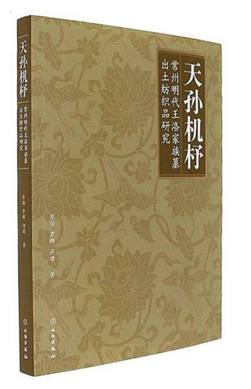
. > WHAT'S NEW > BOOKS
A case study of Ming Dynasty textiles
Author : HUA SHA Source : Chinese Social Sciences Today 2018-06-04

Zhinü’s Loom: A Study on Unearthed Textiles from the Wangluo Family Tombs of the Ming Dynasty Changzhou
Author: Hua Qiang, Luo Qun and Zhou Pu
Publisher: Cultural Relics Press
The textile technology of the Ming Dynasty represented a peak in Chinese textile development. The regions south of the Yangtze River were the most developed and had the most technically advanced textile industry in the Ming Dynasty. Silk fabrics unearthed from the Wangluo family tomb in Changzhou, located on the southern bank of the Yangtze River, were important representatives of silk fabrics of this period.
The Wangluo family tomb was found during an infrastructure construction project in May 1997. It was a typical tomb from the middle of the Ming Dynasty. The tomb was well-preserved and 157 relics or relic fragments were unearthed, including more than 80 textiles and textile fragments. The variety of textile fabrics, the full range of apparel, the fineness of the weave and the richness of decorative patterns were important features of these unearthed cultural relics. In particular, most of the fine textiles were well-preserved and many patterns in these textiles had never been seen.
However, all the excavation records remain untouched in the museum. Most of the exquisitely excavated textiles cannot be displayed due to the limited availability of appropriate exhibition slots, and detailed archaeological reports have not been published yet. Therefore, many important documents have not included the textiles unearthed from the tomb of the Wangluo family. The authors of Zhinü’s Loom keenly grasped this valuable topic. Zhinü is the godess of weaver in the ancient Chinese myth. They investigated the exquisite textiles unearthed from both technical and artistic aspects, and made a detailed examination on the tomb, tomb owners, and unearthed cultural relics, and then used it as a case study to explore the transformation of the clothing culture in the mid and late Ming Dynasty. For instance, the authors analyzed the clothes of the owners of the tomb, and confirmed the transformation of the crown suit system, costume style, and aesthetic tastes of the Ming Dynasty from simplicity to extravagance.
In the study of unearthed textile patterns, the authors were aware that the Chinese decorative patterns were based on the auspicious connotations of certain objects, representing the melding of artistic form and good fortune. These decorative patterns are closely related to people’s daily lives, and reflect Chinese customs, national psychology, social attitudes, historical background and aesthetic tastes. They are also a symbol of Chinese people’s way of thinking, social mentality, values and hopes.
The integration of Confucianism, Buddhism and Taoism, has profoundly influenced the development of traditional auspicious patterns, as have myths and legends, historical stories, folk proverbs, and auspicious words. These are all aspects of the ideological culture and psychological structure of the unique Chinese nation. The authors interpret the cultural implications and artistic features of textiles and jewelry unearthed from the Wangluo family tomb using a combination of methods from multiple disciplines, such as history, sociology, folk studies, archaeology, form analysis, and comparison and graphics.
(Edited and translated by SUI JINGJING)
Ye Shengtao made Chinese fairy tales from a wilderness
Ye Shengtao (1894–1988) created the first collection of fairy tales in the history of Chinese children’s literature...
-
How northern ethnicities integrated into Chinese nation
2023-09-18
-
Mogao caves
2023-09-12
-
Mogao Grottoes as ‘a place of pilgrimage’
2023-09-12
-
Time-honored architectural traditions in China
2023-08-29
-
Disentangling the civilizational evolution of China
2023-08-28
-
AI ethics in science fiction
2023-08-23













 2011-2013 by www.cssn.cn. All Rights Reserved
2011-2013 by www.cssn.cn. All Rights Reserved